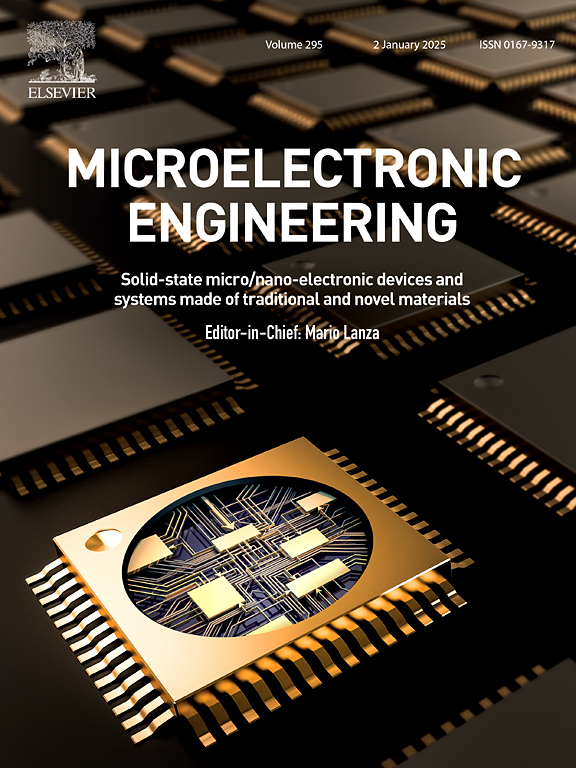电热耦合柔性微波谐振结冰传感器阵列
IF 3.1
4区 工程技术
Q2 ENGINEERING, ELECTRICAL & ELECTRONIC
引用次数: 0
摘要
提出了一种基于电热耦合的防冰除冰柔性微波传感器阵列。柔性传感器阵列利用微波共振原理探测冰的厚度和形状,集成电加热模块,实现一体化防冰除冰功能。冰检测采用对冰层厚度敏感的互补耦合裂纹环谐振器(CCSRR)结构,电加热除冰通过PI(聚酰亚胺)衬底发热丝的柔性结构,结合NTC(负温度系数热敏电阻)实现实时温度反馈。电热膜模块的低功耗运行方式,使系统具有一定的防冰能力。此外,传感器阵列是完全灵活的,使其易于安装在无人机上容易结冰的区域,从而防止结冰影响飞行安全。阵列传感器可以进行多点测量以获取冰形信息。首先,制作了单一电热耦合防冰除冰集成传感器元件,建立了S21参数测试平台,验证了传感器阵列系统的防冰除冰能力。结果表明,所设计的传感器阵列可以识别0.1 mm的冰层。在a-10℃环境下,电热除冰实验表明,4mm的冰层可在20 s内完全融化。传感器阵列的加热效果理想;预热可以有效防止结冰,在除冰过程中可以同时确定除冰程度。电加热防冰模块的低功耗工作方式,保证了系统表面结冰时延迟一倍,单次电加热防冰能耗降低一半。实验证明,冰传感器阵列具有良好的探测冰和防冰能力。本文章由计算机程序翻译,如有差异,请以英文原文为准。

Electrothermal-coupled flexible microwave resonant icing sensor Array
This paper proposes an ice prevention and de-icing flexible microwave sensor array based on electrothermal coupling. The flexible sensor array uses the principle of microwave resonance to detect ice thickness and shape, integrating an electric heating moduleto achieve integrated ice prevention and de-icing functions. Ice detection employs a complementary coupled crack ring resonator (CCSRR) structure sensitive to ice layer thickness, while electric heating de-icing is achieved through a flexible structure of PI(Polyimide) substrate heating wires, combined with NTC(Negative Temperature Coefficient Thermistor) for real-time temperature feedback. Low-power operation mode of electric heating film module endowing the system with certain anti-icing capabilities. Additionally, the sensor array is fully flexible, making it easy to install on areas prone to icing on drones, thus preventing icing from affecting flight safety. The array sensor can perform multi-point measurements to obtain ice shape information. First, a single electrothermal coupling ice prevention and de-icing integrated sensor element was fabricated, and a S21 parameter testing platform was established to verify the ice detection and de-icing capabilities of the sensor array system. The results show that the designed sensor array can distinguish 0.1 mm ice layers. In a-10 °C environment, electrothermal de-icing experiments demonstrated that 4 mm ice layers could be completely melted within 20 s. The heating effect of the sensor array is ideal; preheating can effectively prevent icing, and the degree of de-icing can be simultaneously determined during the de-icing process. The Low-power operation mode of electric heating film module ensures that when icing occurs on the system surfaceThe delay is doubled, and the energy consumption of single electric heating anti-icing is reduced by half. It proves that the ice sensor array has good ice detection and anti-icing ability.
求助全文
通过发布文献求助,成功后即可免费获取论文全文。
去求助
来源期刊

Microelectronic Engineering
工程技术-工程:电子与电气
CiteScore
5.30
自引率
4.30%
发文量
131
审稿时长
29 days
期刊介绍:
Microelectronic Engineering is the premier nanoprocessing, and nanotechnology journal focusing on fabrication of electronic, photonic, bioelectronic, electromechanic and fluidic devices and systems, and their applications in the broad areas of electronics, photonics, energy, life sciences, and environment. It covers also the expanding interdisciplinary field of "more than Moore" and "beyond Moore" integrated nanoelectronics / photonics and micro-/nano-/bio-systems. Through its unique mixture of peer-reviewed articles, reviews, accelerated publications, short and Technical notes, and the latest research news on key developments, Microelectronic Engineering provides comprehensive coverage of this exciting, interdisciplinary and dynamic new field for researchers in academia and professionals in industry.
 求助内容:
求助内容: 应助结果提醒方式:
应助结果提醒方式:


